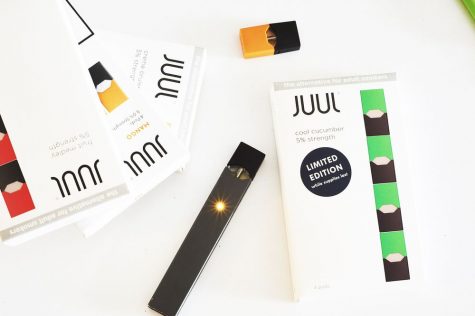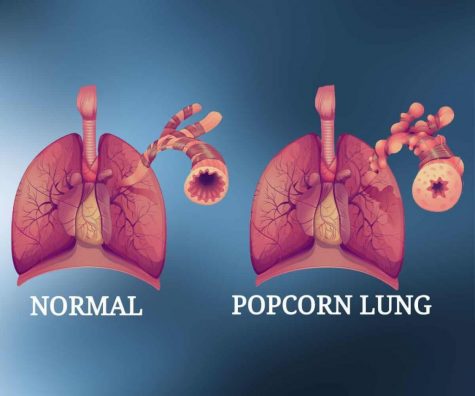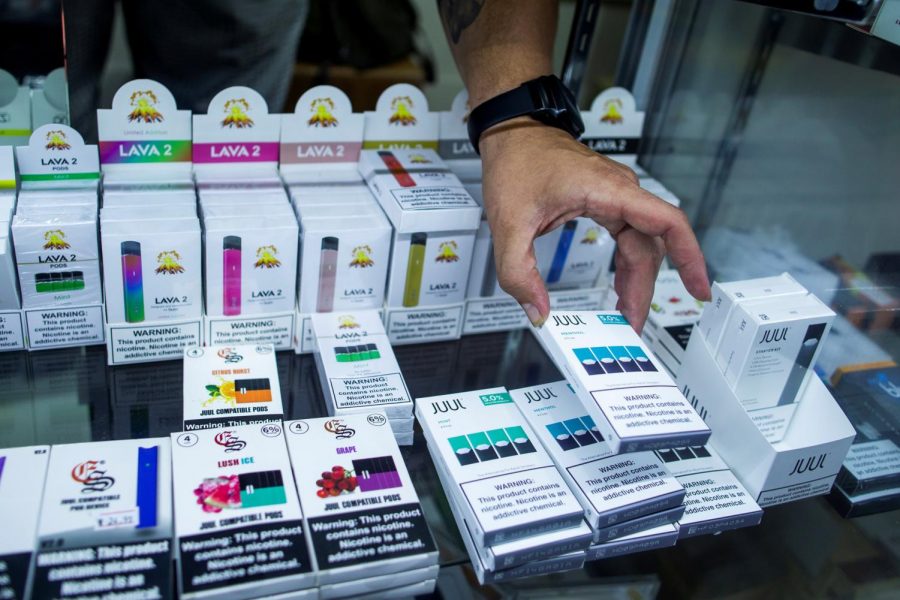PodHeads: Vape Users Not Going Down Without A Fight
Once evaluated at nearly $40 Billion Dollars, Juul has tumbled two-thirds of its price due to new regulations
Once viewed as a healthy alternative to quitting smoking, the electronic e-cigarette Juul is now being viewed as a youth epidemic and health risk. The company holds between a third to three-quarter market share of the e-cigarette business, but addiction to Juuling has caused young teens to develop lung illnesses and death. Juul, a tobacco alternative, has caused 2,172 lung injuries and 42 deaths linked to vaping, according to the latest count from the Center for Disease Control and Prevention.
In September 2019, the Trump administration has had propositions to ban the use of certain flavored pods in the coming year such as mint and mango due to their popularity among young kids. Yet lawmakers are fighting back, insisting e-cigarettes are just as dangerous as their tobacco counterparts.
***
“If I can fight for my country at 18, I should be able to go and buy Juul pods,” 20-year-old Orange County native Mark Sturdevant says, as he holds his device and exhales a sleek white puff of smoke.
He is an avid Juuler, with mango pods being his favorite. He goes through one pod a day. He has been smoking it since the age of 17 in an effort to quit smoking cigarettes.
“I am addicted to nicotine and have been Juuling for three years. It’s the first thing I hit when I wake up and the last thing I hit when I fall asleep,” he says with a smirk.
 Juul, known as the “iPhone of vaping” is an American electronic cigarette that contains nicotine salts and leaf tobacco into one-time use cartridges. A Juul is a small (3.72 inches in length with pod, 0.6 inches in width) chargeable device that requires the insertion of a flavored “pod” in order to smoke it. One pod (200 puffs) contains 20 cigarettes worth of nicotine, but no tobacco.
Juul, known as the “iPhone of vaping” is an American electronic cigarette that contains nicotine salts and leaf tobacco into one-time use cartridges. A Juul is a small (3.72 inches in length with pod, 0.6 inches in width) chargeable device that requires the insertion of a flavored “pod” in order to smoke it. One pod (200 puffs) contains 20 cigarettes worth of nicotine, but no tobacco.
Products from Juul Labs Inc. are currently not approved by the FDA, and the company has until the spring of 2020 to apply for approval as a new tobacco product. The sleek and good-smelling product was valued at $38 billion in 2018, after the tobacco company, Altria invested $12.8 billion for a 35 percent share. Yet controversy and allegations that the company markets its products to the youth has halted the company’s rise. A year later in 2019, investor Tiger Global Marketing lowered the evaluation to $19 billion.
Juul can be a very expensive habit. The Juul device costs around $40. A pack of four pods costs around $15. For Juulers that smoke a pack a day, it adds up quickly. According to a survey by Bankrate, workers on the lower end of the income spectrum earning $30,000 or less spend a greater portion of their income on vices like tobacco and e-cigarettes.
The FDA is also investigating Juul’s use of nicotine salts, a formulation that makes nicotine more palatable to consume and may allow users to take in higher doses at a time.
The Juul company has been hit with numerous lawsuits and flavor bans due to their marketing towards kids between the ages of 13 and 17. New York, California, and North Carolina have filed lawsuits against the company, and several other states including Illinois and Massachusetts are currently investigating the e-cigarette company.
***
Lung Diseases and Respiratory Illnesses are becoming associated with vaping too. Juul’s former CEO, Kevin Burns, stated to CBS that the illnesses linked with vaping are very “worrisome” and troubling. He has since stepped down from his position yet had said in an aired interview, “Don’t vape. Don’t use Juul, don’t start using nicotine if you don’t have a preexisting relationship with the product. You’re not the target consumer.”
Additional experts agree that there are many dangers to exposing children to nicotine.
“When a person seeks out an addiction, their brain is looking for a reward or high from their receptors called dopamine,” said Clinical Social Worker Karen Reids. “Consequences to an early exposure to an addiction such as nicotine could be that they could become hooked before their brain is able to develop healthy coping mechanisms to handle stress and anxiety.”
What Juul does do successfully is it gives users a nicotine high. Nicotine highs include light-headed feelings and the feeling of being dizzy. The advantage to using Juul for consumers is the ease of travel, as they can bring it with them anywhere. Some use it at home, some use it in the car, others at work and school.
Police have said that even though Juuls are not illegal, one could face prosecution for driving without due care and attention.
Sean Ross, a 23-year-old police officer in New Jersey, has a Juul and a Lava vaping device. The Juul has pods inserted into them to get the nicotine e-liquid but the Lava product has to buy e-liquid to put inside of it.
Ross explained when asked why he had two devices, “Sometimes one gives me a better hit than the other. It depends on the day.”
Juul pods are said to have more nicotine than a pack of cigarettes, in an article by Vox in 2018. Ross says that the nicotine helps him when he has headaches or when he gets frustrated on the road.
“It gives me something else to think about,” Ross stated.
Natalie Rivera, a student of the College of Mount St. Vincent, says it feels like it relieves her stress. “I know it’s just my mind messing with me, but I actually get annoyed with myself because when I don’t have it. I act moody and I hate how it can control my emotions.”
Sturdevant has become dependent on the Juul to ease his anxiety.
“When I’m not Juuling, I get pissed off easily and I start to get in a bad mood or have a short temper. I hit it every time I’m done eating.”
The Juul has been causing lung problems and illnesses such as Popcorn Lung, Bronchitis, seizures, and even deaths.
“My friend has Popcorn Lung and he’s still Juuling,” says Sturdevant. “He seems fine. I think if I were to get it I’d keep Juuling too.”
***
 “Popcorn Lung,” or technically bronchiolitis obliterans, is a disease that damages the lungs’ smallest airways. Popcorn lung got its name because it happens when one would breathe in that chemical diacetyl that is used to flavor microwave popcorn.
“Popcorn Lung,” or technically bronchiolitis obliterans, is a disease that damages the lungs’ smallest airways. Popcorn lung got its name because it happens when one would breathe in that chemical diacetyl that is used to flavor microwave popcorn.
Diacetyl is linked to severe respiratory disease. A study was performed by the Harvard T.H. Chan School of Public Health, and they found that diacetyl was found in 39 of 51 flavored e-liquids examined by their researchers. Two similarly harmful chemicals were also found while doing the study: pentanedione and acetoin. They were present in 23 and 46 of the 51 flavors tested. Roughly 92 percent of vape liquids contain at least one of those three chemicals.
WebMD and Lung.org state that popcorn lung takes about two to eight weeks for symptoms to show. Symptoms of popcorn lung include difficulty breathing, wheezing, shortness of breath, and a persistent dry cough. Popcorn lung is life-threatening due to the fact that there is no cure as of right now. Once the condition has developed it will continue constricting the airways. Patients who have it must implement no further lung damage by smoking or vaping.
Diacetyl is found in popcorn, caramel, fruit drinks, and some dairy products. While it’s generally safe to eat, Diacetyl is dangerous when inhaled into the lungs. When breathing, oxygen from incoming air enters the blood, then carbon dioxide leaves the blood. The lungs are not meant to support the inhalation of foreign substances whether they come from cigarettes, drugs, vapes, or anything else. When they do so, their ability to exchange gases (oxygen and carbon dioxide) is reduced, preventing the body from functioning the way it was meant to.
A less life-threatening, short-term illness is bronchitis. Bronchitis is an inflammation of the bronchial tubes in the lungs. The bronchial tubes are the airways that carry air to the lungs.
Bronchitis symptoms are shortness of breath, loss of voice, wheezing, and chest tightness. A low fever also may be a symptom as well. While bronchitis is treatable it does take up to two to three weeks for it to go away and symptoms can start to show after three or four days of having it. People with bronchitis must be very careful because it can turn into pneumonia.
According to the CDC, 4,409 cases of hospitalized e-cigarette or vaping product, use-associated lung injury was reported in the United States and U.S. territories. The patients were at least 24.
As of December of 2019, 52 deaths have been confirmed in 26 states.
The CDC said in December of 2019 that it may have uncovered a potential cause – vitamin E acetate. Samples taken from the lungs of 29 people with EVALI all contained vitamin E acetate. However, vitamin E acetate is commonly used in ingested supplements or skincare, and in those cases appears to be safe. Though, previous research has found that when it is inhaled it may interfere with normal lung function.
Angie Ryan, a 20-year-old Westchester Community college student, is a frequent Juuler. She has been vaping every day for almost a year now, he says. Ryan’s Juul addiction started with the mango flavor Juul pod and she has been hooked ever since.
While smoking Juul, Ryan contracted bronchitis and she went to the hospital because she felt as if something wasn’t right with her body. She was put on prescription and quit her Juul for the three weeks that she was sick. Yet it did not take long to head back to it.
“As soon as I knew my lungs were clear, I continued to Juul,” stated Ryan, who says that Juul is something she can’t let go of. It’s something for her to do when she’s bored at work, home, or even school.
“Getting addicted to the Juul was an accident. It was a trend I wanted to follow and now I’m addicted.”
Juul’s have led to seizures and lung problems as well. Seizures have been seen more and more with vaping cases.
Carina D’Orazio, a Mercy College student, has epilepsy and is also an avid Juuler.
“I started at 17 when my friends were Juuling to ease my stress, and now I’m addicted. I have thrown up from Juuling and my doctors do tell me that they can trigger my seizures, so I plan to stop in the future.”
 One case, in particular, is a YouTuber who is helping bring awareness to how Juuls can affect a person. The YouTuber, Kelani Anastasi, has nearly 30,000 subscribers. In her video, she spoke about how she had a seizure randomly one night after using the Juul for a year.
One case, in particular, is a YouTuber who is helping bring awareness to how Juuls can affect a person. The YouTuber, Kelani Anastasi, has nearly 30,000 subscribers. In her video, she spoke about how she had a seizure randomly one night after using the Juul for a year.
Anastasi said in the video, “I would hit my Juul whenever I was bored and lying on the couch but it got to the point where my body started to feel uncomfortable.”
She fell backwards in her boyfriend’s lap and seized for about two minutes before she came back to consciousness. Anastasi ended up in the hospital and had tests done to make sure she was cleared to leave the hospital.
Her audience clearly related. Some comments from the viewers in the comment section stated: “watching this while hitting my Juul.”
The age that gets sickness most common from Juul is averaged around the age of 24-years-old. A study showed that 80 percent of people who Juul are under the age of 35. More than one-third of that percent is under 21.
In Westchester County, the tobacco age was raised from 18-years-old to 21-years-old in August of 2018.
A worker at Shell gas station stated, “The age has been raised to 21 due to the Juul epidemic. All my years of working here, I have never seen so many young-looking kids coming in to buy tobacco products before this device. We ID very strictly now.”
Westchester County is trying to fight against this epidemic going forward.
Even though most people think that the age of death is younger from vaping and the Juul it isn’t. The average age of a person to get sick from Juuling or vaping is 53, but some feel because Juul is a relatively new product. As time goes on, more side effects could emerge and could end up dying before any research is done. Even though the estimated age of death is 53, the ages range from 17 to 75.
There have been 47 deaths in 25 states from vaping ranging all around the country. Some states are New York, California, New Jersey, and Florida.
One death, in particular, was a 17-year-old male from the Bronx on Oct. 4, 2019. He was the first teen to die from vaping. When doctors did their research, he had died from a vaping-related respiratory illness.
***
Vaping creates a water vapor that users inhale, using cartridges that typically contain nicotine, flavorings, or cannabis products along with chemicals.
E-cigarettes have been found to have chemicals and particles that have been linked experimentally to lung disease, including asthma and chronic obstructive pulmonary disease (COPD). It can also cause lung inflammation.
In 2018, more than 44,000 students took part in a survey of drug, alcohol, and cigarette use by the National Institute of Drug Abuse. The grades ranged from eighth to twelfth grade.
About 37 percent of 12th graders reported vaping in 2018, compared with 28 percent in 2017. This includes nicotine, flavored liquids, marijuana, and hash oil.
According to the study, younger adults are more likely to vape than older adults. Adults between 18 and 24-years-old are three times more likely than average to use e-cigarettes or a similar vaping product, and adults between 25 and 34 years old are twice as likely.
Vaping is even more common among high school students, according to data from the CDC. More than 13 percent of high school students said they had used a vaping product like an e-cigarette at least once in the past 30 days. It added nearly 12 percent of high school seniors use vaping devices with nicotine daily.
Juuling increased among college students from 2017 to 2018. Data shows that the percentages of Juulers in college have gone up from 9 percent to 21 percent.
Part of the problem, according to a 2018 survey, is that younger users do not believe that there is a risk when using Juul. Those under 30 were less likely than older Americans to believe vaping is harmful to one’s health.
According to a tobacco survey taken in 2016, sixth-graders were asked why they prefer Juul, and roughly 31 percent of these students said that they use Juul because of the availability of flavors such as mint, candy, fruit, or chocolate.
About 17 percent of those sixth graders said that they used Juul because they perceived them to be less harmful than other forms of tobacco, such as cigarettes. Others said that they purchase Juul because they are easier to get than other tobacco products such as cigarettes and because the costs were affordable. Only two percent said they tried it because famous people on television or in movies were using e-cigarettes.
Recent data from the CDC’s 2019 National Youth Tobacco Survey confirms that Juul has a foothold in the high school market. More than 59 percent of high school e-cigarette users reported that Juul was their “usual brand.” Among middle school e-cigarette users, the number was more than 54 percent.
Juul had spent more than $100 million to market its products on television and has paid for campaigns on Twitter, Instagram and YouTube by the middle of 2019, according to an article in Adweek, yet suspended its campaign after the backlash about health concerns.
Instagram banned influencers from getting paid to promote vaping on Dec. 17, 2019.
 Shows such as HBO’s Euphoria, which starred Disney star, Zendaya, and Instagram accounts like Bar Stool Sports have featured users using e-cigarettes. Campaigns such as Truth that brought awareness to the dangers of smoking through advertisements have started to produce commercials against e-cigarettes. Their campaign targeted Juul specifically.
Shows such as HBO’s Euphoria, which starred Disney star, Zendaya, and Instagram accounts like Bar Stool Sports have featured users using e-cigarettes. Campaigns such as Truth that brought awareness to the dangers of smoking through advertisements have started to produce commercials against e-cigarettes. Their campaign targeted Juul specifically.
“Despite Juul’s recent efforts to steer their marketing toward current, adult smokers, we know they weren’t always telling that story. Their early ads even reminded us of Big Tobacco’s old ads showing bright, colorful images of young people using their products. We’re less than pleased to see Juul using Big Tobacco’s tactics to target young people, especially considering that their products are insanely addictive. One JUUL pod contains the same amount of nicotine as 20 cigarettes. Not only is nicotine highly addictive, but it can also have a lasting impact on the development of the teenage brain.”
***
Thousands of years before the industry took flight, tobacco was chewed and smoked during religious and cultural events.
In the 1700s, pipe-smoking had become more popular. By the second half of the 1800s, cigarette machines were developed, producing about 200 cigarettes per minute.
Cigarette smoking grew rapidly in the early twentieth century and people became aware of the health effects that it had on smokers. It peaked about 50 years ago, and the rate of American smokers decreased since 1964, according to the CDC. Yet smoking is still the leading cause of preventable death in the country, as nearly 38 million users smoke tobacco a year. The predominant range of smokers are males ages 25 to 64, Native Americans/Alaskans, those who had minimal education, those who lived in the South or Midwest, those who were suffering from psychological distress, and those were of mixed races.
“The bad news is that cigarette smoking is not declining at the same rate among all population groups,” said Brian King, Ph.D., and deputy director for research translation in CDC’s Office on Smoking and Health said in a report. “Addressing these disparities with evidence-based interventions is critical to continue the progress we’ve made in reducing the overall smoking rate.”
Cigarette machines now push out about 9,000 cigarettes per minute.
Cigarettes are made with about 600 ingredients, 69 of which are direct causes of cancer. Cigarette smokers fill their lungs with chemicals such as Acetone (used to remove paint and nail polish), Ammonia (used to clean bathrooms), Arsenic (found in rat poison), Lead (found in batteries), Formaldehyde (used to embalm dead bodies), Tar (used for paving roads), and the infamous Nicotine (used to exterminate insects and highly addictive). And that doesn’t even make a dent in the list of active ingredients.
There are 20 cigarettes in a pack and a pack ranges from $10 to $15. The average American smokes just shy of one pack per day.
The vape industry, in an attempt to decrease the use of tobacco products, was introduced to the world in the mid-2000s. Hon Lik, the inventor of vaping, was very optimistic about his idea of getting nicotine vapor from an electronic device rather than a ‘miniature bonfire between your lips.’
Instead of replacing cigarettes, vaping devices of all kinds have become a habit alongside cigarettes.
The Juul company has a warranty policy that allows users to make an online account and register their Juul devices using the unique serial number comprised of both numbers and letters that is printed on the bottom edge of each device. There is no limit for registered devices per account. If a Juul device is lost or broken, the user is instructed to log in to their account and report the issue being had with the registered device to Juul, who will then mail them a brand new device without a need for collateral. This makes it very easy for users to obtain more devices continuously and free of charge. So, Juul users spend less money overall with the help of services like this one.
Inside of a single Juul pod, there are chemicals such as Vegetable Glycerin (found in both cosmetics and dynamite), Propylene Glycol (used in polyester production, antifreeze, and U.S. military smoke bombs), Benzoic Acid (found in dyes, perfumes, and food preservatives), Nicotine, and various flavors that are full of their own chemicals. Juul devices are also compatible with several off-brand pods.
Whether users are aware they are inhaling these ingredients is debatable.
The American Lung Association explains, “Unfortunately, the Food and Drug Administration (FDA) announced in July 2017 that it would delay until 2022 the requirement that e-cigarette companies submit their products, including all ingredients, to FDA for review. The American Lung Association and our partners filed a lawsuit against the FDA for this delay, but for the meantime, these products remain on the market until FDA begins to enforce the provisions.”
***
Paola Lopez, a Middletown High School senior, despises everything that has to with Juuling.
“I think it’s so pointless and disgusting.. Someone told me they threw up from it and I think that if it’s affecting your own health, it is definitely worse than cigarettes. I know so many acquaintances who are addicted.”
J.J. Santagata, an Ames Hockey Coach, and Personal Trainer is an avid anti-Juuler.
“Sure, a Juul pod does not have tar, methanol or carbon fuel like a cigarette does but the fact that one little pod has so much nicotine, it should raise some concerns…when inhaling nicotine, it goes into your lungs and nose, down to your bloodstream, then into your liver and kidney. Finally, it’s absorbed and metabolized there.”
He adds that it slows metabolism and prevents a healthy diet of nutrients.
“A slow metabolism leads to lack of motivation, low testosterone and estrogen levels, low libido and cortisol, and in the long haul, it’s easier to gain weight and harder to keep weight off.”
Still, others remain loyal to their brand and haven’t given it up yet. Sturdevant aims to quit smoking Juul in 2020 in efforts to save money from his expensive habit.
“I’ve tried quitting for three months. Usually, by the fifth day, it starts getting hard but I’m overcompensating by eating,” he says as he shrugs. “My lungs are probably black and dotted, by whatever .. I’m a fiend for nicotine.”

Amber Perez is half Puerto Rican and half Italian. She is currently residing at The Bronx, New York and enjoys listening to music and reading books about...

Alexis Lynch is currently a senior at Mercy College. At Mercy, Alexis is a Media Studies major with a focus in Journalism. She has gained experience that...













